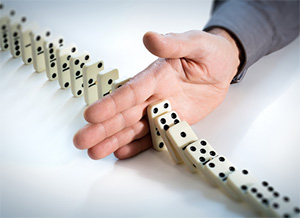
Once we spot the comfort eating triggers, we can identify the pattern and explore ways to stop it
“After the break-up I just hid under the duvet and ate ice cream!”
“After a bad day at work I hole up in front of the TV and eat pizza and French fries!”
“When I feel depressed I binge on chocolate!”
I have heard endless variations on the above over nearly 25 years of practice.
Recently I had a question on our monthly Q&A: Could a client be overeating crisps as a way of feeling close to her father, who had committed suicide? The father also used to eat crisps in the evenings. (If you’re a member you can listen to the recording of this Q&A from 20th July 2017 here, once you log in to Uncommon U).
This set me thinking more generally about comfort eating, or what some psychologists call ’emotional eating’.
Why do we do it?
Whenever we eat when we’re not hungry, that is, when we don’t need to refuel, we do so for one or more of the following reasons:
- We eat for social reasons. It’s polite to eat. It’s expected that we eat.
- We eat habitually. We become conditioned to down chocolate or chips every time a certain TV show comes on, like a Pavlov’s dog automatically salivating to the sound of a bell. One pattern becomes intrinsically linked to another pattern.
- We eat unpalatable food try to deal with unpalatable emotions – otherwise known as comfort eating.
Comfort eating is not in the league of full-blown eating disorders such as bulimia. But for some, regular comfort eating can cause grievous health issues.
But first, let’s be clear: it’s not hard to eat food that will wreck us.
Addictively palatable food, deeply encoded desire
For comfort eating to exist, there needs to be plenty of addictively palatable resources available, which is why it tends to be a first-world affliction. It’s easy to overeat and snack on anti-nutritional ‘foods’, because these substances are designed to be addictively palatable.
In nature, we will always go for what gives us the most energy in the least time. When we hunted for our food (energetically, not in Tesco), there was no guarantee of when we’d next eat. Imagine this:
Your prehistoric buff body is becoming flat-out exhausted from hours of climbing and sometimes sprinting after uncooperative prey. You’ve got nothing. You’re burning energy fast, but you’ve nothing to refuel with. You’ve burnt most of what you last ate, maybe 24 hours ago. But then, something wonderful…
You discover a supply of honey! Don’t ask me how you extract it without getting stung, but you do. Maybe you’ve watched Bare Grills, or whatever his name is.
Anyway, you’ve hit the energy jackpot. All that energy in one hit! The sugar in that honey might just give you the energy to run down that deer so you can eat properly. That natural sugary snack, so high on the glycaemic index, has saved your life.
A nasty case of The Human Condition
So next time someone despondently cries, “I don’t know why I grab the ice cream/cookies/bread when I’m not hungry! What’s wrong with me!?”, you can tell them they have a nasty case of The Human Condition. We evolved to take on huge amounts of carbohydrate when we could get hold of it (which was hardly ever back then).
Yes, we’re hardwired to consume fast-energy-releasing foods. But this is not an excuse, because if we really listen to our instincts we will be able to discern our true requirements for food.
And of course, not having these honey traps (see what I did there?) around is a great idea. If it’s not in the house, it’s not in the mouth. If we let sugary foods be nearby, it’s not so much ‘weakness’ as it is simply being human that drives us to consume them.
Your survival instinct doesn’t care whether you look great on the beach. It will have you reaching for the fastest form of energy to get you sprinting after wildebeest (or, in modern life, settling back on the couch to enable all that insulin to store fat).
But palates and preferences can be retrained. One client filmed in Uncommon Practitioners TV over four sessions, describes how what used to seem alluring no longer does. She starts to see the old ‘comfort foods’ differently – and loses about 70 pounds in the process.
But comfort eating goes well beyond simply getting cheap, short bursts of energy.
Dealing with indigestible feelings
When we feel bad, we are driven to change our state. Alcohol and other drugs do this, but so do chocolate and other refined carbohydrate foods.
Many adults (and children) turn to comfort eating during times of stress or sadness as a way of trying to deal with the difficult feelings. Thirty-eight percent of American adults admit to turning to food when they feel stressed or sad.[1]
But the ‘solution’ is no solution, and in fact becomes a problem in its own right. Chronic comfort eating has consequences for health, fitness, looks and self-esteem.
We describe this behaviour as ‘comfort eating’, but does it actually work? Does eating bad food actually provide comfort for the upset eater?
A road to nowhere
We are, ahem, fed the message that food is a comforter as well as a fuel. And of course if we are hungry, really hungry, then refuelling is comforting, because it means more life! But that’s not the situation we’re talking about.
My client Elaine, also filmed in UPTV, began eating chocolate at night after a break-up with her boyfriend a year before. She describes feeling worse after comfort eating. And her case isn’t at all unusual.
Research carried out back in 2014 found that 81% of people believe comfort eating actually provides comfort by improving a low mood.[2] But researchers found that people’s mood improved just as fast when they ate neutral foods such as salad, or, in fact, no food at all.
So it seems comfort eating doesn’t improve mood or provide comfort, but I suspect it does provide a kind of numbness whilst the person is doing it. I suspect what comfort eating does produce for many is a kind of distracted trance state.
Hundreds of millions follow the siren call into a fat, unhealthy and (more) unhappy state, being led in a kind of mesmerized stupor.
So many clients describe a kind of trance state in which time seems to disappear and they, for a little while, feel switched off from their daily life. But once the eating episode is finished, often it’s as though they reawaken to the reality of what they’ve been doing and often feel worse than they did before.
So as it turns out, comfort eating isn’t much better at improving mood than it is at improving health, at least not beyond the first few initial mouthfuls.
Early (mis)Learning
I think some of the association between self-soothing and food is cultural, and commercials are a big part of that culture. But so are parents.
You might think parents already have quite enough reasons to feel guilty (for which some can turn to secret cream donut trysts), but it does seem that many adult comfort eaters learn this self-sabotaging pattern from the way they are fed as a child.
Researchers have found that emotional eating is:
- not genetic, but learned (from studies of identical twins)[3], and
- often learned in childhood.[4]
Not that it should be a massive shock, but it seems ’emotional feeding’ – giving your child ice cream when they fall over, packing them full of Cheerios when they didn’t get that party invite, or otherwise smothering their body with calories when they feel emotional emptiness – conditions the child to use food as an attempt at feeling better.
And this can persist into adulthood.
If we link comfort eating to unmet emotional needs, then we can see how cramming bad food in can seem like a way of filling a gap.
The Tin Man from The Wizard of Oz was hollow. He needed to feel love again, and for that he needed real experiences that could actually fulfil him – not just fill him.
As a reminder, we all need:
- to give and receive attention
- to feel safe and secure
- to heed the mind–body connection
- to have a sense of purpose and meaning
- to feel a sense of connection to community and of making a difference
- to be stretched, to be creative, and to face manageable challenges
- to experience intimacy
- to feel a sense of control
- to feel a sense of status; to feel valued, appreciated, and respected.
We can see how any of our common human needs could become subverted in an attempt to meet them in ways that don’t really fulfil them, but just seem like some kind of solution.
When people eat though boredom, for example, they might really need to be giving and getting attention, or to pursue greater meaning in their life, or to be challenged creatively.
Of course, what can be learned can also be unlearned.
Some clients use food as an attempted solution to bad feelings so often that they have forgotten what real hunger, a real need to refuel, even feels like. And they may have also forgotten that there are authentic ways of meeting the needs they are grasping for.
Obviously, we can ask our clients to what extent they feel they comfort eat. And about their history of doing so.
But here are a few other ideas.
1. Forget dieting, forget ‘losing’ weight
A diet is like a valley on a hike. You pass through it, but you’re not going to live in it. And that’s the problem.
People see diets as temporary, hard, and full of deprivation.
Generally healthier habits as an ongoing way of living seem to be the way to go. By getting stronger and healthier, we gain our real shape. We don’t have to think about losing anything.
In my work with ‘weight loss’ clients in UPTV, I don’t talk the language of loss much to them. I talk of gaining slimness (or their ‘real shape’), of getting healthy or having the freedom to move the way they are meant to.
Excessive consumption of addictively palatable foods isn’t healthy for anyone, whatever their weight. Gaining independence from the tyranny of compulsion isn’t a diet, it’s part of the process of becoming more fully human.
So unless the client insists on referring to dieting or ‘losing weight’, we can focus with them on increased health, fitness, and control of their own mind and body.
But we need to get more specific.
2. Find the triggers to find the need
Much of life can be a desperate distraction.
We might fill our time with empty experiences in order to feel ‘full’. But unless these experiences genuinely meet our needs for connection to others, for a sense of greater meaning and purpose, for intimacy or challenge, or for feeling safe and secure, then we will be left feeling ‘hungry’.
Often, triggers for comfort eating arise when there is a lull in the distracting noise of the day. We are suddenly confronted with our emptiness. (Because we are not meeting our needs, not because life is essentially meaningless. Don’t worry, I’m not about to put on a turtleneck and a beret and recite bleak poetry.)
We may desperately try to fill this emptiness any way we can. And in our culture this is easily done through, well, any number of self-harming ways, but certainly through food.
“I feel empty in some way, so I will fill up in the easiest way!” would be fine if it actually worked. We could have filled up the hollow tin man with concrete. But it wouldn’t have been a very satisfying ending to the movie.
One man, Neil, whose therapy is soon to appear in UPTV, tells how he works all day with barely a moment for lunch. He takes work home with him and works weekends. But he describes a kind of emotional crisis. Late at night, when the not-so-merry-go-round finally halts, he gorges himself.
Neil wasn’t meeting his needs for fun or intimacy. Life was feeling like an endless, meaningless treadmill. And he was becoming obese.
His trigger was situational. These late evening times. Suddenly the day had ended and there he was, no distractions, only a sense of “I need something!”
Other people may find any difficult interaction, or sense of rejection, or feeling of being unfairly treated, may tip them into comfort eating.
We can find the pattern by finding the triggers. We can also explore some real solutions to our clients’ real needs.
3. Meet their real needs
As the great Persian poet Rumi said, “Fool’s gold exists because there is real gold.”
When we discover what tends to trigger emotional eating, be it fear, exhaustion, loneliness, feelings of rejection, anger, or anything else, then we can find the real need that isn’t being met.
Emotions are signals either that a need has been met (satisfaction, love, enjoyment) or that a need hasn’t been met (fear, anger, despair). Signals can get crossed of course, but emotions are still a good guide to what is lacking in a person’s life.
We can work hard to identify the missing need. We can also develop strategies to be clearer about what the client may really need and start to create the kind of life that genuinely meets those needs. In this way, the life blood of the filling-a-gap behaviour dries up and can begin to naturally be discarded.
But we may still have to deal with the ingrained habit.
4. Access and retrain the trigger feeling
In my UPTV session with Elaine, I ask her to access the steps of the comfort eating. I suggest she access the feeling of really wanting to go to the fridge and get the chocolate out. Because she has ‘practised’ this experience so often, it’s easy for her to access the trigger feeling.
We then rehearse going from the feeling of wanting the chocolate directly to the uncomfortable feeling afterwards of really wishing she hadn’t eaten it.
This isn’t a state of mind and body normally associated with the very first step. But I am, if you like, helping to bring the unpleasant bit right up to the front of the experience so she has a chance to feel the reality of where this path will go if she follows it.
This is an hypnotic technique called scrambling. We begin to scramble or disrupt the old pattern so that it no longer runs so easily if at all.
Most people when comfort eating, or engaging in any addictive focus, will have temporary amnesia of the reality of the feeling of having just gorged or gambled or drank too much. I want the reality to be really there from the very beginning.
We can also mentally rehearse, while the client is deeply relaxed, ‘forgetting’ to emotionally eat, and engaging in healthier behaviours. And by healthier, I mean more likely to meet real needs for the client.
Finally, throughout our work with comfort eating we can do something we also do with smokers or, in fact, anyone besieged by a compulsion or problematic emotional pattern.
5. Externalize and reframe
I’ve written about the dangers of building one’s identity around a problem state. If you believe you are the problem, then getting rid of the problem is akin to getting rid of you. No wonder some smokers look terrified when they realize they might have to stop.
Of course, it’s a cliché to talk in terms of “you are not the depression” or “you are not the anorexia” (although much of modern psychiatry seeks to do the opposite), but we can be much more subtle than that.
When we defamiliarize a pattern, it becomes easier to separate from it. We can defamiliarize it by describing it in metaphorical terms.
I teach practitioners to talk to smokers in parallel, so rather than talking about ‘smoking’ to a smoker (a familiar associative word), we can liken smoking to an abusive relationship. One they need to see for what it is and break free from. I talk about ‘becoming free’ and ‘escaping’, not ‘quitting’ or ‘stopping’.
Then we can continue to talk in this metaphorical way. There’s a UPTV video of me treating a 20-a-day smoker who had smoked for 30 years. I talk very little about ‘smoking’, but I am talking about smoking.
I talk about “it trying to con her back” and how she can “stand up to it” and how “its voice will sound weak and pathetic”. Notice how this externalizes the behaviour and reframes it. It’s very different from saying, “You may get withdrawal symptoms, which you can work to resist!” I make it outside of her so she can separate from it.
We can do this with comfort eating, too. When working with Jane (in UPTV) I talk to her about how ‘it‘ (the unhealthy food) tries to kid her that she needs to have anything to do with it.
I describe it as ‘conning’ and ‘manipulative’, trying to take advantage of her when she feels stressed and vulnerable. Pretty soon she stands up to it and finds she can handle the stresses of life without being pushed around by the old unhealthy foods.
The more we can cast off what is not so good about ourselves, the freer we become.
And anything we are able to cast off isn’t central to who we really are anyway.
Inside UPTV, you can watch me treating real clients in live online therapy videos. Sign up here to be notified with booking is open.
Notes:
- Wagner H. S. , Ahlstrom, B., Redden, J. P., et al. (2014), The myth of comfort food. Health Psychology, vol. 33 no.12, 1552–1557.
- http://www.apa.org/news/press/releases/stress/2013/eating.aspx
- http://onlinelibrary.wiley.com/doi/10.1111/cdev.12799/full
- http://onlinelibrary.wiley.com/doi/10.1111/cdev.12756/full










